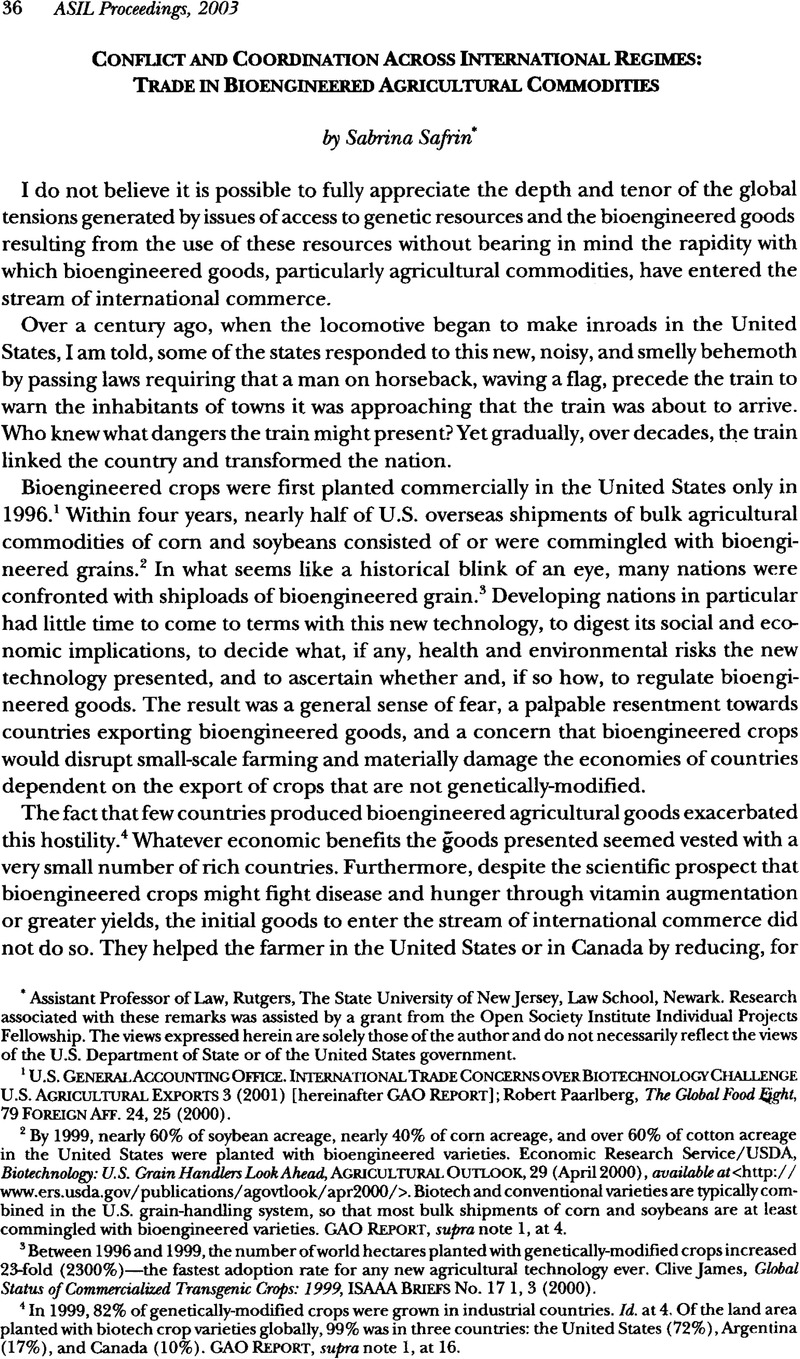No CrossRef data available.
Published online by Cambridge University Press: 28 February 2017

1 U.S. General Accounting office. International Trade Concerns over Biotechnology Challenge U.S. Agricultural Exports 3 (2001) [hereinafter Gao Report]; Paarlberg, Robert, The Global Food Eight, 79 Foreign Aff. 24, 25 (2000)CrossRefGoogle Scholar.
2 By 1999, nearly 60% of soybean acreage, nearly 40% of corn acreage, and over 60% of cotton acreage in the United States were planted with bioengineered varieties. Economic Research Service/USDA, Biotechnology: U.S. Grain Handlers Look Ahead, Agricultural Outlook, 29 (April 2000), available at <http://www.ers.usda.gov/publications/agovtlook/apr2000/>. Biotech and conventional varieties are typically combined in the U.S. grain-handling system, so that most bulk shipments of corn and soybeans are at least commingled with bioengineered varieties. Gao Report, supra note 1, at 4.
3 Between 1996 and 1999, the number of world hectares planted with genetically-modified crops increased 23-fold (2300%)—the fastest adoption rate for any new agricultural technology ever. Clive James, Global Status of Commercialized Transgenic Crops: 1999, ISAAA Briefs No. 17 1, 3 (2000).
4 In 1999, 82% of genetically-modified crops were grown in industrial countries. Id. at 4. Of the land area planted with biotech crop varieties globally, 99% was in three countries: the United States (72%), Argentina (17%), and Canada (10%). Gao Report, supra note 1, at 16.
5 See Cartagena Protocol on Biosafety to the Convention on Biological Diversity (Jan. 29, 2000), 39 ILM 1027 (2000).
6 Convention on Biological Diversity Web site, at <http://www.biodiv.org/biosafety> (last visited May 20, 2003).
7 The Protocol begins with the qualifier “The Parties to this Protocol, Being Parties to the Convention on Biological Diversity....” Biosafety Protocol, supra note 5, 39 ILM at 1027. Article 32 of the Convention on Biological Diversity provides that only states that are parties to the Convention may become parties to its protocols, Convention on Biological Diversity, June 5, 1992, 31 ILM 818 (1992).
8 The Protocol applies solely to living genetically-modified organisms. It governs, for example, the trade in corn but not in corn oil or corn flakes, Article 4 of the Protocol, supra note 5.
9 See Protocol, supra note 5, arts. 7, 8, 39 ILM at 1030.
10 See Outstanding Issues and Necessary Revisions to the Text of the Draft Protocol: Submission by the Miami Group, UNEP/CBD/ExCop/1/3, Annex III, at 17, para. 1 (Feb. 20, 2000), available at <http://www.biodiv.org/doc/meetings>.
11 See Proposal on the Text of the Draft Protocol: Submission by the Like-Minded Group of Countries, Unep/CBD/ExCop/1/3, Annex W, at 19, para. 1 (Feb. 20, 2000), available at <http://www.biodiv.org/doc/meetings>.
12 Id.
13 Id., art. 11, 39 ILM at 1031.
14 For a detailed analysis, see Safrin, Sabrina, Treaties in Collision? The Biosafety Protocol and the World Trade Organization Agreements, 96 AJIL 606 (2002)CrossRefGoogle Scholar.
15 Vienna Convention on the Law of Treaties, opened for Signatare May 23, 1969, art. 30,8ILM 679 (1969).
16 See Outstanding Issues, supra note 10, Annex III, at 17, para. 7(a).
17 See Package Proposal on the Text of the Draft Protocol: Submission by the European Union, UNEP/CBD/ExCop/1/3/, Annex II, at 15, 16, para. 3 (Feb. 20, 2000), available at <http://www.biodiv.org/doc/meetings>
18 Biosafety Protocol, supra note 5, pmbl., cl. 10, 39 ILM 1027 (2000).
19 Id. at cl. 9.
20 Id. at cl. 11.
21 38 ILM 1 (1999).
22 This treaty, adopted on November 3, 2001, is available at <http://www.wto.org/english/tratop_e/trips_e/t_agm0_e.htm>.
23 See Safrin, supra note 14, at 622-27.
24 Id. at 624.
25 Id.